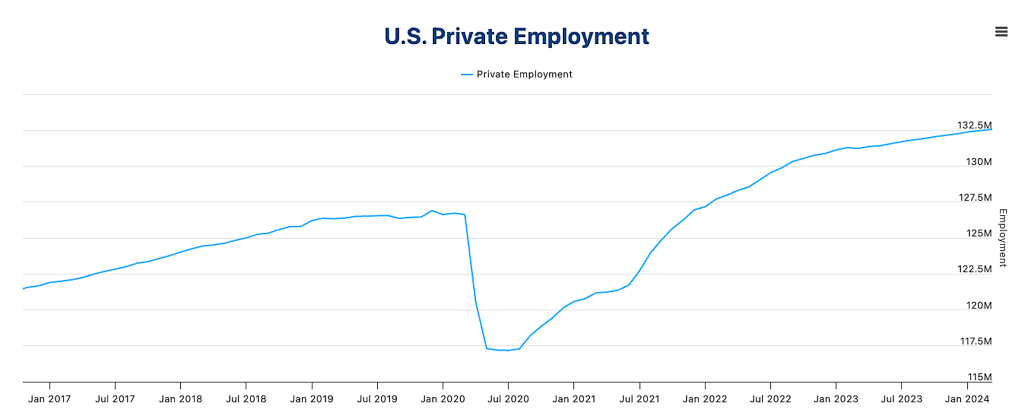As AI redefines work, US employers cut jobs and remain cautious in hiring
Even without the latest monthly jobs report from the US Bureau of Labor Statistics because of the US government shutdown, other sources made one thing clear: employers are still making cuts and remain reticent to hire.
Private employers shed 32,000 jobs in September, according to a report from global HR and payroll solutions provider ADP.
Pay gains were largely unchanged for those who retained their jobs at 4.4% year-over-year; pay gains for people who changed jobs last quarter were 6.6%.
“Despite the strong economic growth we saw in the second quarter, this month’s release further validates what we’ve been seeing in the labor market, that U.S. employers have been cautious with hiring,” said Nela Richardson, ADP’s chief economist.
Larger employers (with more than 500 workers) were more apt to hire than mid-size and smaller organizations, according to ADP’s data. Large companies in the US hired 33,000 people in September, while mid-sized firms (with 50-499 employees) let 20,000 workers go and small companies (fewer than 50 employees) let go of 40,000 workers.
One bright spot for hiring was “knowledge workers,” which includes technologists. Hiring of those workers increased by 3,000 last month. Education and health services jobs also saw significant gains, as 33,000 new workers were hired.

ADP
A ‘market under pressure’
Ger Doyle, regional president for ManpowerGroup in North America, described the hiring-firing shift as “a pivot” and “not a pause.”
“September reveals a market under pressure, with signs of continued softness,” he said. “Even without today’s BLS report, the labor market isn’t silent; it’s speaking through real-time signals. The labor market is reshaping in real time, and opportunity lies in how organizations reimagine entry points, invest in internal mobility, and build their workforces for what comes next.”
Hiring is slowing, with new job postings totaling 2.04 million, down 8% month over month and at their lowest level since December 2022, according to Doyle. Open roles have dropped to 6.86 million, down 10% — their lowest point in four years.
“September, typically a turning point for the labor market, hasn’t brought the lift we expected,” Doyle said.
Through ongoing surveys, ADP measures “employee sentiment” or how people think and feel about their jobs and employers. Its latest data showed knowledge workers’ motivation, in particular, remains high. In September, that motivation score climbed one point to 136, a sixth straight record high.
“People are holding onto their jobs and appear motivated to work,” said Mary Hayes, director of People and Performance at ADP Research.
Companies are shifting focus inward, with more employees staying put and internal moves up 11% year-over-year. External hiring is down, signaling a growing emphasis on career development and lateral mobility, ManpowerGroup’s data revealed.
Skills vs. resumes
The World Economic Forum predicts that while 92 million jobs will be displaced globally by 2030, 170 million new ones will be created. That’s why companies must shift to skills-based hiring rather than relying solely on resumes, according to Sibyl McCarley, Chief People Officer at HR tech provider Hirevue.
When considering new hires, 80% of corporate executives will prioritize skills over degrees, with half planning to increase freelance hiring this year to close the gap in AI and other skills, according to a new study from freelancing platform Upwork.
“When roles emerge that didn’t exist five years ago, past job titles alone won’t tell you who’s qualified,” McCarley said. “Organizations that embrace this forward-looking approach will be better positioned to compete. That being said, we are seeing reductions in entry-level positions that are instead being fulfilled by artificial intelligence [AI].”
Many organizations, she said, are now weighing AI as an alternative to workers before backfilling roles. While the larger impact is still limited, each lost job is personal and leaders must respond with empathy, she said. If AI-driven displacement accelerates, there need to be serious strategies in place to support those affected, McCarley said.
Broader economic forces, such as President Donald J. Trump’s tariffs, policy uncertainty, and the rising cost of capital investments, are contributing to workforce disruption, McCarley added.
Ben Johnston, COO of small business lender Kapitus, said US businesses are grappling with tariffs that raise costs on imported goods, potentially making domestic manufacturing more competitive long term. But in the short term, those tariffs risk driving up inflation and disrupting global supply chains, threatening jobs across the manufacturing, wholesale, and retail sectors.
AI is also beginning to displace workers, especially in white-collar jobs. Companies are currently investing heavily in AI technologies that can analyze data and quickly make decisions that once could only be made by humans, Johnston said.
Companies are using AI to gather and analyze data from the web, internal systems, and third parties — tasks once done only by humans — mainly in white-collar roles like analytics and underwriting. And as robotics advance, AI could soon take on physical tasks in blue-collar jobs like driving, factory work, and even home healthcare, Johnston noted.
ManpowerGroup’s Doyle agreed, saying as roles evolve, especially under the influence of AI and automation, the expectations for entry-level talent are changing.
“The ability to orchestrate, adapt, and work alongside emerging technologies is becoming a baseline requirement,” he said. “For many, the first step into the workforce now looks very different than it did even a year ago.”
Read more: As AI redefines work, US employers cut jobs and remain cautious in hiring